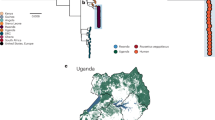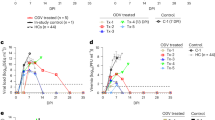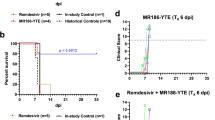Abstract
The September 2024 outbreak of Marburg virus disease (MVD) represented the first time this virus was identified in Rwanda. Health authorities mounted a rapid and effective response, including the rapid execution of an open-label Phase 2 clinical trial of an investigational Marburg vaccine, beginning just 10 days after the outbreak was declared. We share lessons from this rapidly executed clinical trial to help encourage outbreak research preparedness in other countries.
Similar content being viewed by others
Introduction
The recent outbreak of Marburg virus disease (MVD), declared on September 27, 2024, represented the first time this virus was identified in Rwanda (https://rbc.gov.rw/marburg/). Health authorities mounted a rapid and effective science-based response and contained the outbreak successfully; there were 66 confirmed cases of MVD and 15 related deaths1. The response was notable for the rapid deployment of an investigational Marburg vaccine in an open-label Phase 2 clinical trial (pactr.samrc.ac.za/TrialDisplay.aspx?TrialID=32010) just 10 days after the outbreak was declared (Fig. 1). This aspect of the response was a real-world test of the rapid clinical trial component Rwandan government’s 100 Days Mission (100DM) goal [https://static.cepi.net/downloads/2024-02/CEPI-100-Days-Resport-Digital-Version_29-11-22.pdf]. We describe the 100 DM and the factors that enabled this rapid vaccine research response.
The 100-day mission
The 100DM is an ambitious initiative to develop and authorize vaccines for emergency use within 100 days of identifying an emerging pathogen with epidemic or pandemic potential. Initially proposed by the Coalition for Epidemic Preparedness Innovations (CEPI), the goal has since been welcomed by public and private sector entities alike, all recognizing that actions taken to develop a vaccine in the first 100 days also set the stage for manufacturing scale up and equitable vaccine deployment.
Accelerating vaccine development will require a high degree of scientific, operational, and logistical preparedness at each step of the development process, as well as coordination and collaboration across public and private sectors. Beyond the creation and manufacture of a vaccine, rapid execution of early clinical studies, including those that assess safety and immunogenicity with an investigational vaccine, are an essential component of the 100DM. Advancing readiness also requires testing early detection systems, availability of diagnostic tests, assessing logistical and operational capabilities through table-top exercises and live-fire drills, and iteratively incorporating lessons learned from real-world response2.
Because the 100DM is fundamentally about preparedness and moving as quickly as possible to advance vaccine research and development (R&D) in the context of an ongoing public health threat, the concepts and techniques embedded in it can benefit the research response to any outbreak, not just emerging pandemics of novel diseases.
Rwanda was the first country in the Global South to adopt the 100DM, initiating plans in 2023 for a 100DM office within the Rwanda Ministry of Health (MoH). It established collaborations with a range of entities involved in the end-to-end components of the 100DM: surveillance, vaccine development and manufacturing, clinical trials, and vaccine deployment. A critical component was a public-private partnership between the MoH providing stewardship and technical expertise; Ginkgo Bioworks, which supports Rwanda’s capacity for pathogen detection and characterization including through wastewater surveillance; IQVIA, a quality harmonization and surge partner for the clinical trial capacity need to enable early authorization of a vaccine; BioNTech, a vaccine developer that is building a messenger RNA (mRNA) vaccine manufacturing facility in Rwanda; and CEPI, which is supporting this initiative as a pilot of 100DM implementation at the country level. The partnership leverages technical expertise across the partners and other key Rwandan institutions, including the Rwanda Biomedical Center (RBC), which is responsible for laboratory work, supply chain, and research implementation, including clinical trials.
Rwanda MoH hosted partners for its first tabletop exercise of the 100DM on September 11, 2024, around a hypothetical, highly contagious and virulent variant of Rift Valley Fever Virus. The same week, CEPI joined the Rwanda Food and Drug Administration (FDA) in a regulatory preparedness table-top exercise. Together, these exercises generated significant enthusiasm for moving quickly in the event of a real outbreak and recognition that a whole-of-government commitment would be needed in the face of a similar public health emergency. The partners also deepened their understanding of one another’s capabilities to leverage core strengths, identified priority gaps and actions for the subsequent year, and developed trusted, working relationships. Additional insights included that speed comes from conducting multiple processes in parallel; context-sensitive, practical clinical trial pre-designs are needed; scientific knowledge, including about a vaccine candidate’s safety and immunogenicity, can be advanced while offering a potentially protective vaccine; and the high degree of community trust in the Rwandan health authorities needs to be maintained to enable vaccine trials and vaccination campaigns in the context of public health emergencies. The participants committed to reconvening a year later to conduct an exercise with live demonstration components, including in the manufacturing arena.
The partners did not have the luxury of preparing for another year. Unbeknownst to the time of the exercises, a Kigali miner had already become ill with Marburg virus disease (MVD), sparking the Rwandan outbreak3. As soon as the outbreak was recognized, the Government of Rwanda (GoR) instituted a range of public health measures to contain the spread and began mobilizing a medical countermeasures research response. This included initiating a Phase 2 clinical trial to expand knowledge of the safety and immunogenicity of an experimental vaccine in its frontline and healthcare workers and other contacts of infected individuals on day 10 of the response. We describe the series of events that enabled this achievement, in line with the lessons learned from the 100 DM exercise.
Mobilizing the vaccine research response
Fortunately, this outbreak did not require de novo vaccine development, as several vaccine candidates were already in clinical development and had been prioritized by the World Health Organization (WHO) for use in clinical trials. [https://www.who.int/publications/m/item/who-technical-advisory-group---candidate-vaccine-prioritization.--summary-of-the-evaluations-and-recommendations-on-the-four-marburg-vaccines] While confirmatory diagnostic testing was still underway, the Rwandan Government immediately contacted CEPI and the Sabin Vaccine Institute (Sabin) to notify them of a potential MARV outbreak.
Sabin is developing a chimpanzee adenovirus type 3-vectored vaccine candidate (cAd3-Marburg vaccine) with a strong safety profile, with support from the U.S. Biomedical Advanced Research and Development Authority (BARDA) (part of the Administration for Strategic Preparedness and Response in the Department of Health and Human Services). Sabin notified BARDA of the likely incoming request from the GoR to donate doses of the investigational vaccine and confirmed the amount of vaccine that could potentially be made available for use in a clinical trial. Nearly simultaneously, CEPI contacted IQVIA to mobilize clinical trial support if needed.
Over the ensuing few days, Rwandan health authorities reviewed several trial design options in the context of the outbreak and considered the benefits and risks, as well as the opportunities of deploying the vaccine to different populations under the rapidly changing conditions of the outbreak. While the review of trial designs was ongoing, the Rwanda FDA approved the previously planned WHO Solidarity CORE ring trial protocol [https://www.who.int/publications/m/item/core-protocol-a-phase-1-2-3-study-to-evaluate-the-safety-tolerability-immunogenicity-and-efficacy-of-vaccine-candidates-against-filoviruses-disease-in-healthy-individuals-at-risk-of-filovirus-disease] as a precautionary move so that a protocol would be available if needed. Ultimately, Rwanda’s leadership determined that a ring vaccination was operationally complex under the specific circumstances of the outbreak. Nearly all contacts of the initial cases were in a single, overlapping ring, making it challenging to randomize effectively between immediate and delayed vaccination. The protocol also introduced a significant risk of delay in immunization for individuals within the ring, potentially compromising the rapid containment of the outbreak and the protection of high-risk populations. In view of the historically high mortality rate for Marburg virus disease of up to 88% (https://www.cdc.gov/vhf/marburg/outbreaks/chronology.html), the country’s leadership concluded that the national priority was to offer an experimental vaccine to frontline and health workers and high-risk contacts, potentially safeguarding them and contributing to broader outbreak control efforts. The Government then adapted the WHO solidarity CORE protocol to align with that goal, first offering immediate vaccination with an investigational vaccine that had reasonable evidence of a manageable safety profile and potential efficacy in an open-label, Phase 2 trial format with the intent to transition to a ring trial if the outbreak grew.
With Rwanda’s public health priorities clarified, RBC, the national lead for research and trial sponsor, formed a partnership team to support the execution of the trial and related activities; representatives from RBC, Sabin, IQVIA, and CEPI met daily throughout the course of the outbreak to plan, anticipate, and troubleshoot vaccine deployment through the trial. As an example of learning from the 100DM exercise about conducting activities in parallel, the protocol was submitted to the Rwanda National Ethics Committee (RNEC) and Rwanda FDA for concurrent review and was rapidly approved with RBC as the study sponsor. Simultaneously, the team, supported by IQVIA, conformed to required GCP compliance for the clinical trial, including site preparation, and within 42 h, assessed critical components for the implementation of the trial and prepared an additional context-appropriate protocol based on the WHO ring-vaccination design as a contingency for potential outbreak expansion.
Meanwhile, the existing doses of vaccine were with Sabin’s manufacturing partner, ReiThera, in Italy, which had an existing approved export permit for the vaccine for use in Phase 2 clinical studies. While the clinical trial protocol was under review, the Rwanda FDA worked side-by-side with Sabin to review relevant data and agree on requisite labeling to enable an import permit for the vaccine. Together, Sabin, ReiThera, and BARDA identified vaccines for use in Rwanda, packaged and labeled them, and arranged shipment by international courier to Kigali, Rwanda; the first shipment of vaccine arrived on October 5. The trial began the following day, once all GCP components were in place, and by the end of October 2024, over 1700 frontline and healthcare workers and high-risk contacts had received the investigational vaccine and were being monitored.
Implementation of the trial was expedited thanks to Rwanda’s strong healthcare infrastructure, including the use of mobile vaccination clinics, consolidated response efforts in research, laboratory, surveillance, supply chain and storage under the MoH and RBC, as well as the trust of Rwandan citizens in government recommendations- demonstrating the country’s capacity to conduct seamless multi-site clinical trials. The outbreak was declared over on December 20, 2024.
While the clinical trial continues to assess the safety and immunogenicity of the vaccine, it is critical to note that although this trial provides some data to support the development of Sabin’s candidate vaccine, there are significant limitations. The absence of a negative control arm creates challenges with the interpretation of the safety data and limits the ability to generate efficacy data, although it may be possible to monitor the impact of vaccination on the severity of the disease in the event that there are breakthrough MVD cases in vaccinated individuals. Of note, the Rwanda MVD outbreak is one of the largest MVD outbreaks in history. Even though the outbreak response and vaccination occurred at unprecedented speed, only 17 new MVD cases were identified after vaccination commenced, and the majority of these occurred in isolated individuals within known transmission chains. Had a larger epidemic occurred, the team was prepared to move beyond an uncontrolled Phase 2 trial to a randomized controlled trial (RCT). To date, MVD outbreaks have all been too small to support an RCT in a single outbreak, or historically, in multiple outbreaks.
Multiple preconditions made this rapid response possible, but important challenges remain (Table 1). First and foremost was the existence of an investigational vaccine with existing Phase 1 data, with available manufactured doses and partners (Sabin and BARDA) willing to make it available. De novo vaccine development, an overall goal of the 100DM, was not required or tested in this real-life event. Additionally, critical pre-conditions were the leadership of the Government of Rwanda and the existing 100DM Rwanda partnership with its active relationships and work across the public and private sectors. The insights generated from the Rwanda 100DM table-top exercise—conducting activities in parallel, adapting trial designs to country context, and building and maintaining trust, partnership, and open communication between all the parties—were all considered essential to the MVD vaccine response.
The successful response efforts have further inspired Rwanda and its partners to pursue the 100DM concept and advance its epidemiological and genomic surveillance capabilities through strategic collaborations with partners. Although doses were ready from Sabin during this outbreak, rapid manufacture of the vaccine is central to a rapid response. The 100DM partner BioNTech is nearing completion of its Rwanda facility and anticipates multiple drills of rapid development and manufacturing processes, which are critical. Rwanda, CEPI and its partners will continue to champion the 100DM globally, with inspiration from the speed of response achieved during Rwanda’s MVD outbreak likely encouraging other countries to begin planning for the 100DM in operational and logistical terms.
While all the preconditions for replicating this success may not be present in a subsequent outbreak, Rwanda and its partners have demonstrated that the kind of speed that is foundational to the 100DM is possible when partners commit, invest in preparedness, and build mutual trust in advance.
Data availability
No datasets were generated or analysed during the current study.
References
Rahim, F. O. et al. Rwanda’s science-led response to Marburg virus holds lessons for other outbreaks in Africa. Nat. Med. 3, 1055–1056 (2025).
Saville, M. et al. Delivering Pandemic Vaccines in 100 Days: What Will it Take?. N. Engl. J. Med. 387, e3 (2022).
Sibomana, J. P. Fight or Flight-Facing the Marburg Outbreak in Rwanda. N. Engl. J. Med. 391, 2070–2072 (2024).
Acknowledgements
We are indebted to the large team that executed the public health response and the clinical trial. Development of the Sabin cAd3-Marburg vaccine has been funded in part with federal funds from the Department of Health and Human Services Office of the Administration for Strategic Preparedness and Response Biomedical Advanced Research and Development Authority under Contract Numbers 75A50119C00055 and 75A50123C00010. We thank Gwen Tobert, Kwasi Amfo, and Siham Elhamoumi for comments on the manuscript.
Author information
Authors and Affiliations
Contributions
S.N. N.B. and Y.B. provided government support and leadership for the trial. N.B., H.S., V.M., J.N., E.R., E.R. executed the trial. R.H., S.B., J.C., C.F., A.H., N.L., E.T., V.L. provided leadership, operational and policy support to the trial. A.F., and K.W. provided operational, logistical and policy support for the trial and access to the vaccine. N.B., A.F., K.W., A.H., J.C., C.F., N.L., V.L., S.B., and E.T. operationalized the study and contributed to writing the paper. N.L. and S.N. wrote the first draft of the paper. All authors reviewed the paper and approved its content.
Corresponding author
Ethics declarations
Competing interests
The authors declare no competing interests.
Additional information
Publisher’s note Springer Nature remains neutral with regard to jurisdictional claims in published maps and institutional affiliations.
Rights and permissions
Open Access This article is licensed under a Creative Commons Attribution-NonCommercial-NoDerivatives 4.0 International License, which permits any non-commercial use, sharing, distribution and reproduction in any medium or format, as long as you give appropriate credit to the original author(s) and the source, provide a link to the Creative Commons licence, and indicate if you modified the licensed material. You do not have permission under this licence to share adapted material derived from this article or parts of it. The images or other third party material in this article are included in the article’s Creative Commons licence, unless indicated otherwise in a credit line to the material. If material is not included in the article’s Creative Commons licence and your intended use is not permitted by statutory regulation or exceeds the permitted use, you will need to obtain permission directly from the copyright holder. To view a copy of this licence, visit http://creativecommons.org/licenses/by-nc-nd/4.0/.
About this article
Cite this article
Nsanzimana, S., Bigirimana, N., Hatchett, R. et al. How Rwanda mounted a research response with an investigational vaccine just ten days into a Marburg outbreak. npj Vaccines 10, 178 (2025). https://doi.org/10.1038/s41541-025-01224-8
Received:
Accepted:
Published:
DOI: https://doi.org/10.1038/s41541-025-01224-8




